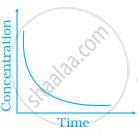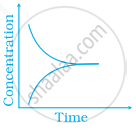Advertisements
Advertisements
Question
Bromine monochloride, BrCl decomposes into bromine and chlorine and reaches the equilibrium:
\[\ce{2BrCl (g) ⇌ Br2 (g) + Cl2 (g)}\]
for which Kc= 32 at 500 K. If initially pure BrCl is present at a concentration of 3.3 × 10–3 molL–1, what is its molar concentration in the mixture at equilibrium?
Solution
Let the amount of bromine and chlorine formed at equilibrium be x. The given reaction is:
| 2BrCl(g) | ↔ | Br2(g) | + | Cl2(g) | |
| Initial conc. | 3.3 × 10-3 | 0 | 0 | ||
| At equilibrium | 3.3 × 10-3 - 2x | x | x |
Now, we can write,
`(["Br"_2]["Cl"_2])/["BrCl"]^2 = "K"_"C"`
`=> (x xx x)/(0.0033 - 2x)^2 = 32`
`=> x/(3.3 xx 10^-3 - 2x)` = 5.66
⇒ x = 18.678 × 10-3 - 11.32 x
⇒ 12.32 x = 18.678 × 10-3
⇒ x = 1.5 × 10-3
Therefore, at equilibrium,
[BrCl] = 3.3 × 10-3 - (2 × 1.5 × 10-3)
= 3.3 × 10-3 - 3.0 × 10-3
= 3.0 × 10-4 mol L-1
APPEARS IN
RELATED QUESTIONS
\[\ce{PCl5, PCl3 and Cl2}\] are at equilibrium at 500 K in a closed container and their concentrations are 0.8 × 10–3 mol L–1, 1.2 × 10–3 mol L–1 and 1.2 × 10–3 mol L–1 respectively. The value of Kc for the reaction \[\ce{PCl5 (g) ⇌ PCl3 (g) + Cl2 (g)}\] will be ______.
\[\ce{pH}\] of a solution of a strong acid is 5.0. What will be the \[\ce{pH}\] of the solution obtained after diluting the given solution a 100 times?
Calculate the \[\ce{pH}\] of a solution formed by mixing equal volumes of two solutions A and B of a strong acid having \[\ce{pH}\] = 6 and \[\ce{pH}\] = 4 respectively.
Match the following graphical variation with their description
| A | B |
(i)  |
(a) Variation in product concentration with time |
(ii)  |
(b) Reaction at equilibrium |
(iii)  |
(c) Variation in reactant concentration with time |
